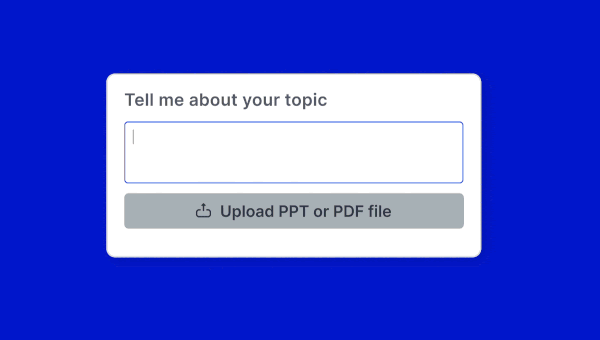Investors hear hundreds of pitches. Most are filled with numbers, projections, and jargon, but what makes one stand out? A great story.
Facts matter, but stories stick. A compelling investor pitch presentation doesn’t just share data—it connects emotionally, builds trust, and sparks excitement about your vision.
With Prezi AI, you can create an AI investor pitch deck that blends cinematic storytelling, clean design, and real data, all in minutes.

What is an investor pitch deck?
An investor pitch deck is your visual story. An investor pitch deck is a concise presentation that explains your business, highlights your opportunity, and inspires confidence in your team.
It’s not just slides. It’s the bridge between your idea and an investor’s belief in it. A strong pitch deck answers one key question: Why should I invest in you?
Investor pitch examples that work
The best investor pitch deck examples share three traits:
- Clarity — they communicate complex ideas simply.
- Emotion — they tell a story investors remember.
- Credibility — they back emotion with data and traction.
With Prezi’s AI-powered presentation maker, you can create a pitch that offers a dynamic flow, taking your potential investors on a journey to make your case.
Why storytelling is the secret to a winning investor pitch
Storytelling is what turns your facts into feelings and your vision into belief.
A great story gives your pitch:
- Context for your data
- Personality for your brand
- A clear vision for the future you’re building
Investors who can relate to your story can remember your business long after the meeting ends.
Craft a story that converts
Your investor pitch story should have:
- A mission: The bigger vision you’re pursuing
- A hero: Your customer
- A problem: The pain they face
- A solution: Your product
Prezi’s format makes this structure feel intuitive – all you have to do is add your content into Prezi AI, and it will lay out the investor pitch story for you.
How to create an investor pitch deck: A step-by-step guide

Start with a clear goal
Before designing anything, you should first define your purpose. Is your goal to raise your first round, follow up, or seek strategic investors? Every word and visual should support your central goal: showing why your business is a smart, scalable investment.
Research your audience
Not all investors are the same. Tailor your deck based on what matters to them—industry fit, growth stage, or ROI expectations. Personalize your narrative to align with their investment philosophy and portfolio.
Structure around key slides
Here’s what every AI investor pitch deck should include:
- Introduction: Who you are and your mission
- Problem: What pain point you’re solving
- Solution: How your product addresses it
- Market Opportunity: The size and potential of your market
- Business Model: How you’ll make money
- Traction & Metrics: Proof of progress
- Team: Why you’re the right people for this
- Financials & Forecast: Realistic, data-backed growth
- Vision & Ask: What you need and why now
Prezi AI can generate a complete draft pitch deck from just a short prompt—helping you visualize your ideas instantly.
Designing an investor pitch deck that stands out

Go beyond slides
Traditional decks are static; Prezi AI lets your ideas move. Its cinematic zooming canvas connects concepts fluidly, helping investors see the big picture and the details—all at once.
Create a visual hierarchy
Your most important message should dominate each view. Use bold typography, clear colors, and simple layouts. Prezi AI recommends visual arrangements automatically, saving you hours of manual design.

Visualize data with impact
Replace dense tables with elegant charts and infographics. In Prezi, you can zoom into data sections and transform stats into charts.
Use AI for speed and style
Don’t start from scratch. With Prezi AI, you can describe your idea—“Create an AI investor pitch deck for a fintech startup”—and get a ready-to-edit presentation built around your narrative. Each design is unique, not a generic template.
Keep it cinematic
Remember: movement grabs attention. Prezi’s motion-based format guides your audience through your message. This makes your investor pitch presentation feel more like a story, instead of just clicking through a slideshow.
Delivering your investor pitch presentation with confidence
Your delivery brings your story to life. Even the best deck needs passion behind it.
Practice for flow
You want to know your deck well enough that you can present naturally, without reading from slides. The best pitches feel like conversations, not lectures.
Engage with emotion
Investors invest in people as much as products. Show your excitement, vision, and resilience. A calm but passionate tone builds credibility.
Handle questions gracefully
Anticipate tough questions about financials, competition, and scalability. Be transparent. If you don’t know an answer, say you’ll follow up. Honesty builds trust.
Adapt for virtual meetings
In a remote pitch, your screen presence matters. With tools like Prezi Video, you can appear beside your content instead of disappearing into a screen share, keeping your story human and dynamic.
Build lasting investor relationships
Your pitch isn’t the finish line; it’s the starting block for a long-term partnership. Investors are backing you and your team as much as they’re backing your idea. Securing funding is just one part of the equation. The real work lies in building a relationship founded on trust, transparency, and shared goals. This means your efforts shouldn’t stop the moment you walk out of the room. The post-pitch phase is where you can solidify an investor’s confidence in you and lay the groundwork for a successful collaboration.
Think of it this way: the pitch gets their attention, but the follow-through earns their trust. Investors hear hundreds of pitches, so what makes you memorable is often the professionalism and persistence you show afterward. They’re not just writing a check; they’re joining your journey. They want to see that you’re a reliable, communicative, and coachable founder they can work with for years to come. By focusing on clear communication and genuine connection, you can turn a single meeting into a lasting and fruitful relationship that extends far beyond the initial investment. Let’s cover the key steps to making that happen.
Create an effective follow-up plan
The meeting might be over, but the conversation is just beginning. A prompt and professional follow-up shows your commitment and keeps the momentum going. Within 24 hours, send a personalized thank-you email. Reiterate your appreciation for their time, briefly summarize the key takeaways from your conversation, and attach your pitch deck. Most importantly, make the next step clear. Whether it’s providing additional data they requested or scheduling a follow-up call, your goal is to make it easy for them to continue the dialogue. A well-structured follow-up strategy can be the difference between a warm lead and a missed opportunity.
Network with purpose
Remember that investors are people first. Your goal is to get them excited about you and your business, and that starts with building a genuine connection. Before the meeting, do your homework on their background, interests, and portfolio. Look for common ground that goes beyond business. During your conversation, listen as much as you talk. Building rapport isn’t about a hard sell; it’s about finding alignment. They want to like and trust the founders they work with. Approach every interaction as an opportunity to build a relationship, not just secure a transaction. This human-centric approach will make you more memorable and trustworthy.
Manage your investor communications
Building a relationship requires consistent, thoughtful communication. It’s not enough to just follow up once. You need a system to manage your interactions and keep investors engaged over time. A simple spreadsheet or CRM can help you track who you’ve spoken to, what you discussed, and when you should reach out next. Provide periodic, concise updates on your progress—hitting a milestone, a key hire, or a significant product development. This keeps you top-of-mind and demonstrates your ability to execute. With tools designed for professional teams, you can create clear, compelling updates that respect their time and reinforce their confidence in your vision.
Why use Prezi AI for your investor pitch deck
Prezi AI isn’t just another presentation tool; it’s your AI-powered storytelling partner.
- AI design in seconds: Turn ideas into polished decks instantly.
- Cinematic storytelling: Go beyond static slides with zooming visuals.
- Custom, not templated: Every presentation is built around your unique content.
- Engaging delivery: Present side-by-side with your story for maximum impact.
Whether you’re showing investors your traction, financials, or future, Prezi AI helps you design an unforgettable AI investor pitch deck that inspires action.
An unforgettable investor pitch blends emotion, clarity, and design. When you tell a powerful story, supported by data and brought to life through cinematic visuals, you do more than seek investment. You invite investors to join your journey.
With Prezi AI, you can create, design, and present that story faster than ever—so your ideas don’t just get seen, they get remembered.
Frequently Asked Questions
How long should my pitch deck actually be? While there’s no magic number, a good rule of thumb is to aim for 10 to 15 slides. The goal is to be concise and impactful enough to start a conversation, not to present every single detail of your business plan. Each slide should have a clear purpose and communicate one main idea. Think of it as a compelling summary that leaves investors curious and eager to learn more.
What if my company is pre-revenue and I don’t have solid financial projections? This is a common situation for early-stage startups, and investors understand it. Instead of presenting concrete historical data, your focus should be on demonstrating a well-researched and logical financial plan. Show your work by explaining the key assumptions behind your projections, based on market size, your business model, and data from comparable companies. It’s less about having a perfect prediction and more about proving you have a credible strategy for growth.
Should I focus more on the story or the data in my pitch? It’s not a matter of choosing one over the other; you absolutely need both. Think of them as a team. Your story creates the emotional hook that makes investors care about the problem you’re solving. The data then provides the logical proof that your solution is a viable and scalable business. A compelling narrative without solid numbers feels like a dream, while data without a story is forgettable. Weave them together to create a pitch that is both inspiring and believable.
Is it okay to admit I don’t know the answer to a question during the Q&A? Yes, it’s not only okay, it’s often the best approach. Honesty builds far more credibility than trying to invent an answer on the spot. A confident and professional response is to say something like, “That’s an excellent question, and I want to give you the most accurate information. I’ll follow up with the exact details after our meeting.” This shows you’re thoughtful, coachable, and committed to accuracy—all qualities investors look for. Just be sure you follow through promptly.
How can I make my virtual pitch as effective as an in-person one? To make a virtual pitch land, you have to be more intentional about creating a connection. Since you can’t rely on physical presence, your on-screen energy and visuals must work harder. Make sure your lighting and audio are excellent, and practice looking directly at the camera to simulate eye contact. Using a dynamic presentation tool that allows you to appear alongside your content can also make the experience feel more personal and engaging than a standard screen share.
